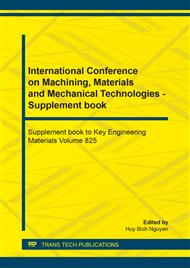[1]
N.C. Singer, W.P. Seering, Preshaping Command Inputs to Reduce System Vibration, ASME Journal of Dynamic System, Measurement and Control 112 (1990) 76-82.
DOI: 10.1115/1.2894142
Google Scholar
[2]
W.E. Singhose, N. Singer, W. Seering, Comparison of Command Shaping Methods for Reducing Residual Vibration, In Proc. 3rd European Control Conference, Rome, 1995, pp.1126-1131.
Google Scholar
[3]
S. Brock, Identification of the parameters in inverted pendulum model [DC motor control], in Proc. 7th International Workshop on Advanced Motion Control, Maribor, 2002, pp.316-321.
DOI: 10.1109/amc.2002.1026938
Google Scholar
[4]
I. Ivanov, P. Hubinsky, L. Jurisica, Elimination of Pendulum Residual Oscillation in Electromechanical System Containing Pendulum, In Proc. 14th International Conference on Electrical Drives and Power, High Tatras, (2001).
Google Scholar
[5]
Y. Yoshida, H. Tabata, Visual feedback control of an overhead crane and its combination with time-optimal control, In Proc. 2008 IEEE/ASME International Conference on Advanced Intelligent Mechatronics, Xian, 2008, pp.1114-1119.
DOI: 10.1109/aim.2008.4601818
Google Scholar
[6]
A. Albarbar, S. Mekid, A. Starr and R. Pietruszkiewicz, Suitability of MEMS Accelerometers for Condition Monitoring: An experimental study, Sensors, 8 (2008) 784-799.
DOI: 10.3390/s8020784
Google Scholar
[7]
R. Gao, L. Zhang, Micromachined Microsensors for Manufacturing, IEEE Instrumentation & Measurement Magazine, 7 (2004) 20-26.
DOI: 10.1109/mim.2004.1304562
Google Scholar
[8]
Q. K. Duong, Motion Control of Multi-axial Vibrational Mechatronic Systems (Doctoral Dissertation), (2016), Slovak University of Technology.
Google Scholar
[9]
Q. K. Duong, P. Hubinsky, Shaping NURBS Curve Based on Genetic Algorithms for Vibration Reduction, International Journal of Mechanics and Control, 18 (2017) 85-90.
Google Scholar
[10]
http://www.heidenhain.com/fileadmin/pdb/media/img/20887128_Measuring_Devices_For_ Machine_Tool_Inspection_and_Acceptance_Testing.pdf.
Google Scholar
[11]
https://www.st.com/resource/en/datasheet/DM00027543.pdf.
Google Scholar


